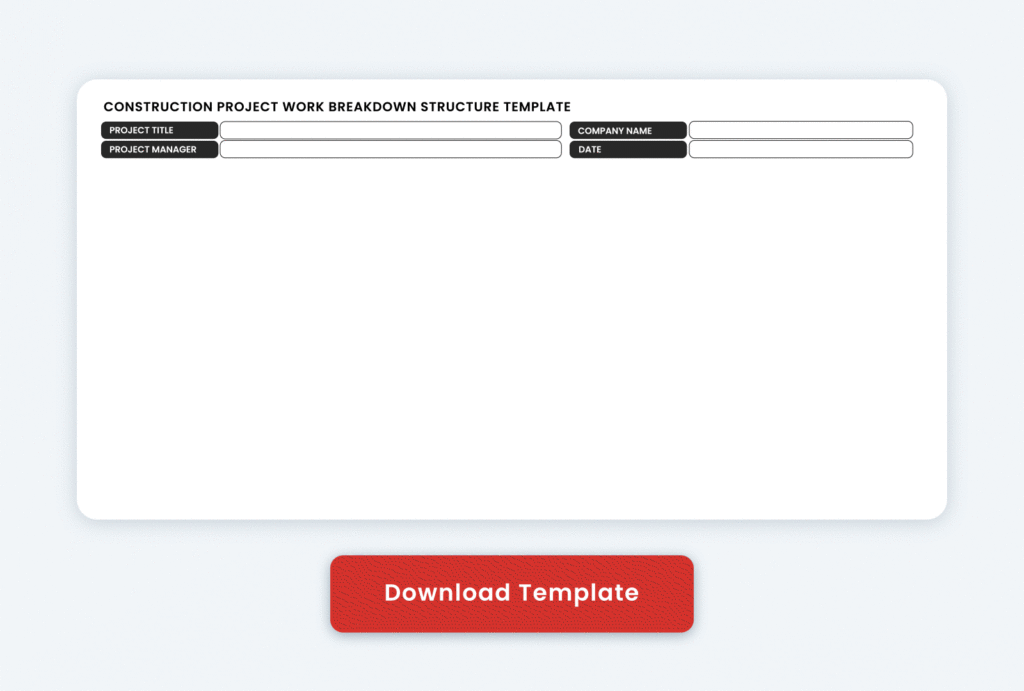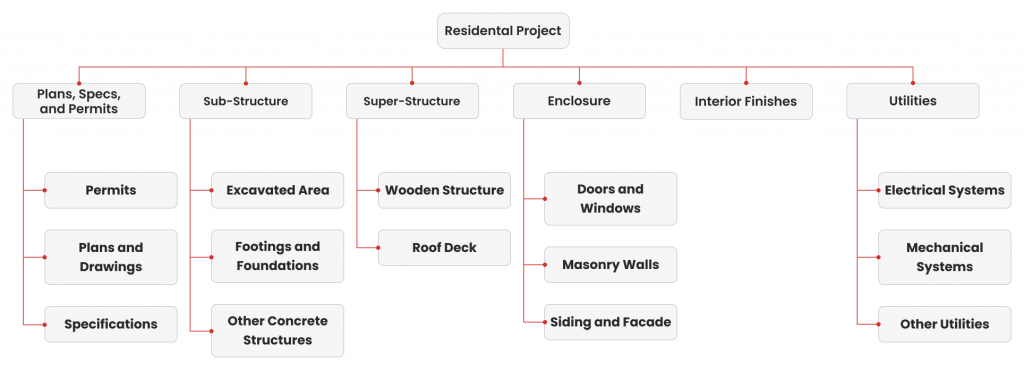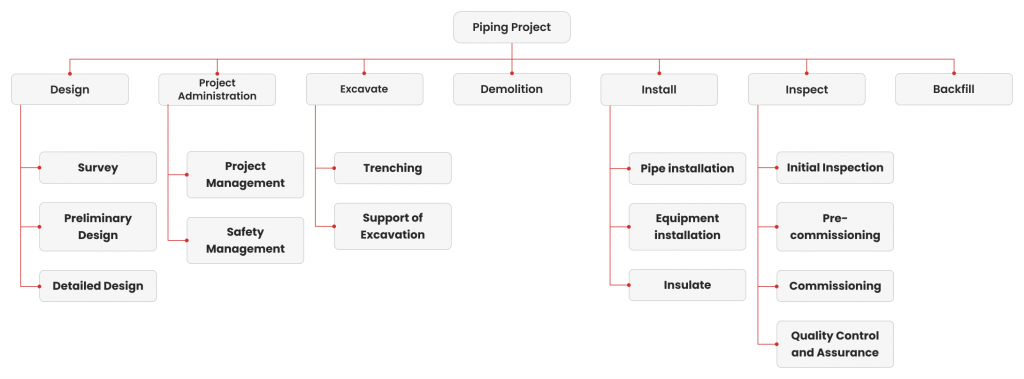Rome wasn’t built in a day. It would have been split into manageable chunks with deliverables ticked off one by one. Otherwise, the gladiators would have fought in half-built, over-budget colosseums.
That’s what a work breakdown structure does for you. It breaks down big tasks into smaller, more manageable ones - making a complex project a series of simpler deliverables.
Let’s get into what a WBS is and how you can leverage the technique for success.
Look out for templates and examples.
What is a Work Breakdown Structure in project management?
Work Breakdown Structure is a visual project management technique for tracking and aligning a project's scope of work, project budget, and schedule.
It breaks down your entire project into small manageable tasks so that the project manager and their team members can get work done on time and on budget.
Nothing is less productive than to make more efficient what should not be done at all.
– Peter Drucker, management consultant, educator, and author.
You can connect your work breakdown structures to your construction-specific financial processes through cost breakdown structures and cost codes.
Work Breakdown Structure template
Here's a ready-to-use work breakdown structure template for your construction project, from Smartsheet.

What are the key components of a Work Breakdown Structure?
Here are the key elements that make up a sound WBS:
- Project Scope: a brief description of the project charter with the project plan
- Project Schedule: includes project timeline, completion date and task status across deliverables
- Key stakeholders: an organisational chart of project participants across management along with responsibilities.
- WBS dictionary: a document that helps all key stakeholders gain clarity on various WBS terminologies and WBS elements.
- Work packages: the 'lowest level of WBS that gets assigned to a team member', according to the Project Management Body of Knowledge (PMBOK) book by the Project Management Institute.
- Control accounts: you create work packages and group them together as 'control accounts' for easy status tracking.
- Project tasks: includes all the tasks with duration, description, dependencies and the team/people responsible for execution.
What are the three types of Work Breakdown Structure?
A sound WBS makes the project easier to manage and you have three to choose from. None are inherently better. It’s about choosing the right one for the project.
The deliverable-based WBS
In deliverable-based WBS, you break down the project scope with a hierarchical decomposition approach.
In simple terms, this means you split the large project into smaller, more manageable bits and create a hierarchy. Each level represents a progressively more detailed breakdown of the deliverables.
For example, you might have the overall goal or objective at the top. The next level down will be small components or phases, which will be broken into tasks and deliverables on the level down.
This means you create a work package and organise them into control accounts. It's suitable for projects with specific to-dos and quick turnarounds.
Here's a deliverable-based WBS example for the residential construction project, from Adroit

The phase-based WBS
In a phase-based WBS, you create work packages with tasks by using the project phases. In the example below, there are five elements (phases):
- Design
- Procurement
- Construction
- Inspection
- Turnover
These phases are pretty standard but you can adapt them to your needs. Below level two elements are the deliverables for each phase - the control accounts, which you’d break down into work packages.
It doesn’t matter what type of WBS you choose, the lower levels are always deliverables.
Here's a phase-based WBS example for a piping project, from Adroit

Here’s what that looks like with the terminology we spoke about before:
The responsibility-based WBS
A responsibility-based WBS is created on the organisational chart of project participants, which consists of teams and task owners.
The second WBS level will include the ownership structure and the lower levels identify project deliverables.
Here's a responsibility-based WBS example for an online shop, from Visual Paradigm
Why is the Work Breakdown Structure crucial to construction?
Construction projects are expensive, complex and long. That increases risk and makes the cost of failure a scary prospect.
That’s where the WBS steps in and offers a calming hand.
Here’s how:
Helps to breakdown complex projects
A construction project will have a complex scope that involves many tasks across the construction phases. Using a WBS, you can break down the project scope into manageable work packages with progress and cost tracking.
Gives you a clear path to project success
It’s easy (and understandable) to get overwhelmed when drafting a project plan from a project scope. By visually representing the work, you can strategise to optimise with a bird's eye view.
Meet your project goals (and avoid scope creep)
The WBS sticks to the project scope. Every work package should only include the work demanded by the parent task. This means you can avoid scope creep and ensure you only do the work you’re paid for - and get paid when extra work comes up by referring back to the WBS.
Helps you track progress and manage project costs
A WBS follows the 100% rule - which means it must include all project deliverables in the project scope across engineering, procurement, or construction.
This means you can easily track the progress and ensure work gets executed as per the project plan.
"The WBS ensures that you have 100% of the project covered or encapsulated under that work breakdown structure. Nothing is worse than missing a whole area of work and this can act as a checklist to help you ensure that you don't miss major elements of work."
- Tom Stephenson, PM Tips: What is a work breakdown structure
Give management the tools to make informed choices
You can treat a WBS like a Gantt chart to visualise project progress and also track costs against elements, phases and deliverables.
There are plenty of formats available online to do this. It makes creating and sharing easy-to-understand reports a cinch.
Improves communication among stakeholders
A WBS software or tool simplifies and democratises project information for everyone.
Construction project teams can share updates in real time, recognise any potential delays, and synchronise to take action. By speaking the same project language, you reduce to-and-fro communication and limit misunderstandings.
Creates a framework for continuous improvement
A WBS makes it easy to draft project management documents for SOPs and reporting. Based on status updates, you can modify project deliverables, milestones, and quality control expectations - and optimise on-ground execution accordingly.
How to create a construction work breakdown structure
Your typical WBS for construction has 3 main levels - the first is of the final project outcome, the middle-level lists project deliverables and the bottom level includes the work packages for each parent task.
Here’s how to create WBS for a construction project: building a house.
Step-by-step process of creating a WBS for construction project management
Step 1: Determine resource availability
Collect all the information on the construction project. This includes information like engineering studies, pre-design work, drawings, project financials, past project data, management objectives, sales proposals, supplier information, etc.
Step 2: Create a project plan
Using information from the first step, create the project charter, project budget and WBS dictionary. In our work breakdown structure example, our project objective is to construct a house.
Step 3: Create a work breakdown structure format
Choose one out of the 3 WBS types discussed in this article. Then, decide on a WBS format from choices like kanban boards, Gantt charts, calendars or flowcharts.
In our construction WBS example, we have selected a phase-based WBS depicted using a tree diagram.
Step 4: List phases and project deliverables
First, create a parent task list based on the WBS type chosen. For example, to construct a house, the WBS levels will look this -
Level 1: Construction of a house
Level 2:
- Internal - further divided into subtasks like Electrical, Plumbing
- Foundation - further divided into subtasks like Excavation, Steel Erection
- External - further divided into subtasks like Masonary work, building finishes
Step 5: Create work packages
Keep dividing the subtasks such that you get the lowest level of work that can be assigned to team members. These tasks should be discrete such that you can estimate their budgets, fix timelines, and track completion status.
In our example, we can create work packages for a few parent tasks:
- Steel Erection - Place columns, install beams, joists, etc
- Electricals - install wirings, HVAC equipment, rough-in electrical, etc
On completion of the above 5 steps, you can design a simple tree diagram to get your construction Work Breakdown Structure for a house as follows:
Source: matchware.com
Why you need to get the team involved in the work breakdown structure creation
The WBS doesn’t sit in a vacuum. Each step involves other companies, teams and people. Each one needs to understand their role in the project and the WBS justifies their to-do list. There will be no ambiguity.
Include them early as they’re experts in their roles, meaning they can sense check and add value during the planning. By involving the stakeholders in the process, you also instil a sense of accountability.
Tips for Creating a Strong Work Breakdown Structure
Here is a 10-point checklist to ensure your construction work breakdown structures are perfectly usable:
- Your WBS should only cover the project scope with the subtasks adding up to the parent task.
- Your WBS needs at least 2-3 levels. Only add more levels to make your WBS work packages more 'manageable'.
- Stop tasks from overlapping or repeating across the construction project's WBS.
- Keep WBS work packages at the bottom so you can estimate costs, define quality measures, fix timelines, and track their completion date.
- Make your WBS easy to understand. You can use colour coding, hierarchical lists, or WBS-specific tools.
- Check if your WBS misses any phases or steps in your construction project.
- Do not focus on 'actions'. Instead, optimise for 'outcomes'.
- Your divided tasks should have a hierarchy, reasonable timeline, and clarity on the input-output sequence.
- Make sure your project team members understand how to read and update the WBS.
- Consult subject matter experts and take feedback from project participants.
What WBS challenges can you expect?
Getting the WBS wrong can derail the rest of your project management efforts. Since creating one is a team effort, as a project manager, you may face below challenges:
Managing the project team dynamics
One of the biggest challenges we faced was resistance to change. Some team members were hesitant to adopt a new methodology, which resulted in delays in implementing WBS.
However, we overcame this challenge by providing training and support to our team members, which helped them understand the benefits of using WBS and how it could improve project management.
- Isaac Robertson, CEO of Total Shape
Grasping the WBS concept can be tricky and lead to pushback. That’s why you need to get the buy-in and manage the process. The results speak for themselves.
Creating WBS is time-consuming
"The WBS takes time to develop, and many organisations are under pressure to start their projects quickly. But taking the time to create a WBS upfront will save time and effort later in the project."
- Project Management Institute (PMI)
You will spend longer drafting a sound WBS for larger projects. It’s normal. But using templates, learning from past projects and establishing SOPs can reduce how long it takes.
Turning the WBS into a schedule of works
Your WBS is not the project schedule or programme of work - it just plays a role. Don’t overload the WBS with details and deadlines at this stage. Stick to the deliverables, not the sequencing.
Lots of incomplete or inaccurate data
Using inaccurate data for WBS can compound into larger issues and risks during the project. Make sure the information included is as accurate as possible. But also leave room for unforeseen deliverables.
Things to avoid when creating a WBS
Here’s a list of things you need to avoid when creating the work breakdown structure.
Failing to involve all team members in the creation process
Give your project team clarity on the project scope and delivery expectations. Failing to onboard the team means the project manager cannot incorporate team insights and feedback into the WBS structure.
Creating too many or too few work packages
You waste serious time when adding the minutest of tasks to the WBS. The same goes for going overboard. Yes, you need to follow the 100% to cover the project scope but you need to recognise when you’re making the WBS complex or too simple.
Failing to assign responsibilities for each work package
A WBS lets you estimate the projects’ labour and duration for the project which helps with project budgeting and risk management. Don’t stop there, ensure you reasonably assign each work package and get feedback from your team.
Failing to establish change control
You undoubtedly know about the scope creep trap. We’ve all been burned before. That’s why it’s important to establish change control and ‘monitoring SOPs’ to accommodate any customer-driven or team-driven changes.
Extra tips on how to use a WBS in construction
Now that we know how to create a WBS for construction projects, let's look at how to make the best use of them:
- Assign responsibilities: After securing the work packages' buy-in from key stakeholders, assign them to respective team members. Incorporate any feedback and solve their concerns for a smooth delegation.
- Set deadlines: Use past project data and consult with the team members to fix a reasonable completion date for the tasks assigned.
- Track progress: Incorporate SOPs for progress tracking. You can automate project tracking by using work breakdown structure software tools.
- Monitor costs: Compare estimates with on-ground execution expenses to take timely measures for cost control.
- Communicate with stakeholders: Set up relevant communication channels to update and report on project status.
- Adjust as required: while the project charter ideally should not change, you can adjust the activities as the situation demands.
Frequently asked questions (FAQ)
What is the 8-80 rule in WBS?
The WBS “8-80” rule says you no task says that no chunks of work can take less than 8 hours and longer than 80 hours to complete. This means tasks are between one 8-hour working day and two full working weeks for two operatives.
Who is responsible for the WBS?
Everyone involved in the project is responsible for the WBS creation and execution. It must be usable and comprehensive for all stakeholders. The project manager will drive the process and manage all the moving pieces.
What is the most important thing in the WBS?
A well-made WBS should successfully turn 100% of a complicated project scope into manageable deliverables and work packages.















